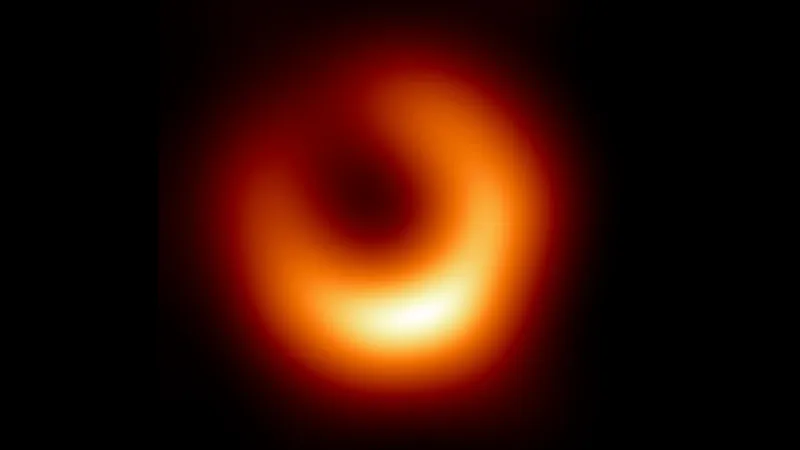
Prepare to Be Amazed: New Satellite Constellation to Unlock the Mysteries of Black Holes!
2025-01-04
Author: Siti
Introduction
In a groundbreaking advancement that could transform our understanding of the universe, researchers in South Korea are developing a satellite constellation designed to observe supermassive black holes like never before. This innovative initiative, named Capella, promises to take our observational capabilities to new heights—literally.
The Driving Force Behind Capella
Leading the charge is Professor Sascha Trippe of Seoul National University, an esteemed astronomer specializing in black holes. Frustrated by the limitations of existing technologies, Trippe believes that without significant advancements, our research into these cosmic phenomena may hit a "dead end."
Milestones in Black Hole Imaging
The unveiling of the first-ever image of a supermassive black hole in 2019, which depicted the one at the center of the Messier 87 galaxy, was a milestone for astrophysics. This iconic image revealed a glowing ring encircling a dark void, confirming the existence of black holes—regions of space where gravity is so intense that not even light can escape. A subsequent image in 2022 of the black hole residing in our own Milky Way galaxy reignited public interest, yet for experts, these images fell short of perfection.
Challenges of Existing Technologies
The primary challenge lies with the Event Horizon Telescope (EHT), a global network of radio telescopes functioning together as a singular observatory through a process called very long baseline interferometry. According to Trippe, the EHT measures only one point of the target image at a time, leading to incomplete images that require extensive processing, which obscures many structural details. For instance, the powerful jet of gas launching from Messier 87 at light speed remains undetected in the iconic 2019 image.
The Capella Constellation
The Capella constellation is set to change the game. By placing satellites in orbit, researchers can capture higher frequency radio signals, which are currently hindered by Earth's atmosphere. This breakthrough means that the new satellite network would provide clearer images and improved accuracy, all while bypassing the limitations faced by ground-based telescopes.
Design and Capabilities
The constellation will consist of four satellites positioned at altitudes between 280 and 370 miles (450 and 600 kilometers). This network would not only surpass the coverage area of the EHT in terms of image quality, but it would also allow for continuous measurements without the gaps inherent to terrestrial instruments. As these satellites traverse the globe multiple times each day, they promise an unparalleled view into phenomena occurring near the event horizons of black holes.
Potential Insights and Scientific Impact
With enhanced resolution, scientists will be able to decipher the formation of the relativistic jets emerging from accreting black holes—insights that are critical yet currently unattainable. "We would really like to understand how these jets are formed," Trippe elaborated. The anticipated capabilities could yield faster imaging of black holes in nearby galaxies, enabling more precise mass estimations.
Funding and Future Prospects
Despite past challenges in launching large radio telescopes into orbit, technological advancements are making it possible to create smaller, cost-effective systems. Trippe estimates that the entire Capella project could be developed for under $500 million. Excitingly, South Korea's nascent Korea Aerospace Administration is reportedly considering funding this stellar endeavor, with a decision expected next year.
Conclusion
If successful, the Capella constellation could revolutionize our understanding of the greedy giants lurking at the heart of galaxies as early as the 2030s. Prepare to have your mind blown as we venture into the depths of space and unravel the secrets of black holes—stay tuned!

 Brasil (PT)
Brasil (PT)
 Canada (EN)
Canada (EN)
 Chile (ES)
Chile (ES)
 Česko (CS)
Česko (CS)
 대한민국 (KO)
대한민국 (KO)
 España (ES)
España (ES)
 France (FR)
France (FR)
 Hong Kong (EN)
Hong Kong (EN)
 Italia (IT)
Italia (IT)
 日本 (JA)
日本 (JA)
 Magyarország (HU)
Magyarország (HU)
 Norge (NO)
Norge (NO)
 Polska (PL)
Polska (PL)
 Schweiz (DE)
Schweiz (DE)
 Singapore (EN)
Singapore (EN)
 Sverige (SV)
Sverige (SV)
 Suomi (FI)
Suomi (FI)
 Türkiye (TR)
Türkiye (TR)
 الإمارات العربية المتحدة (AR)
الإمارات العربية المتحدة (AR)